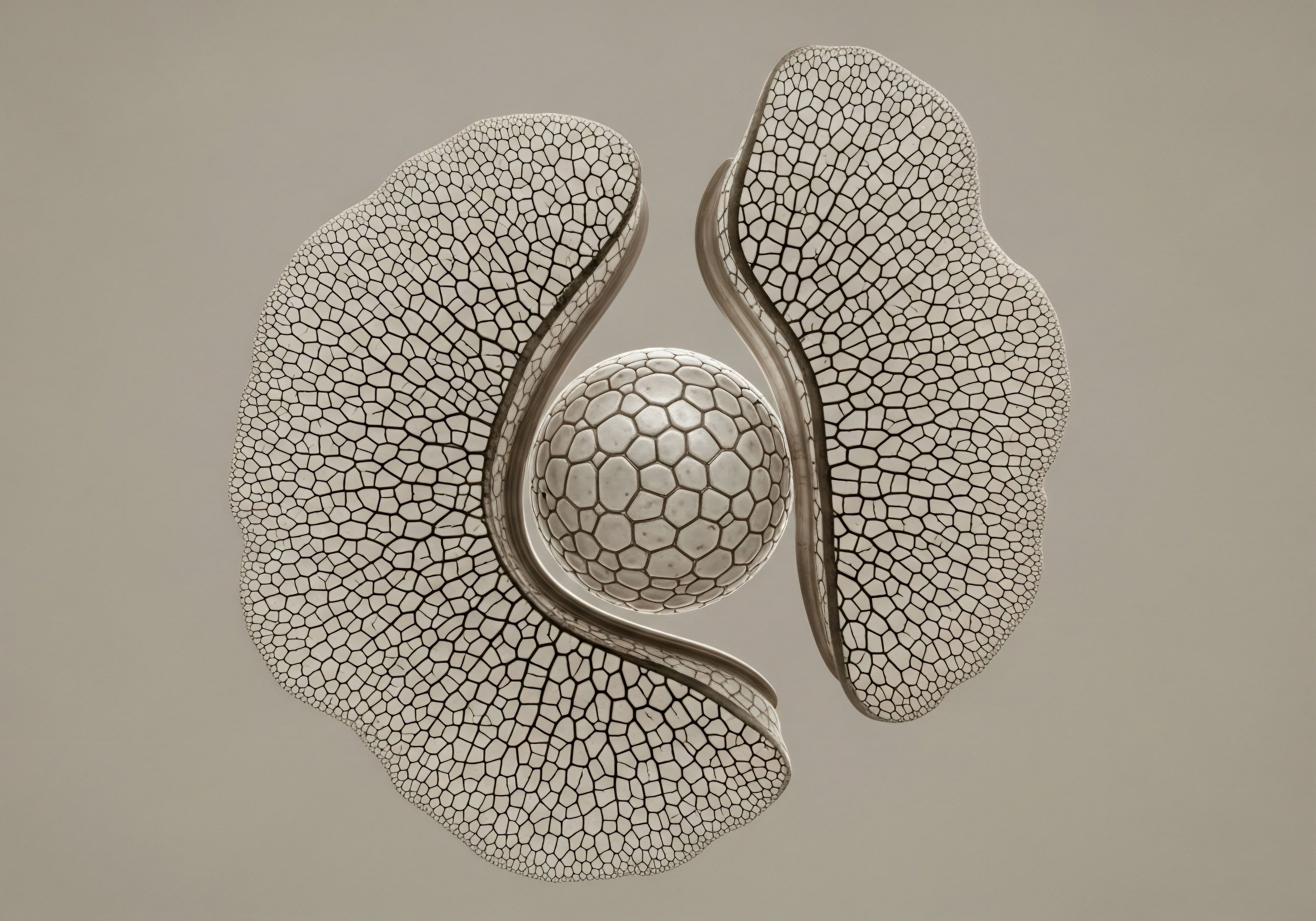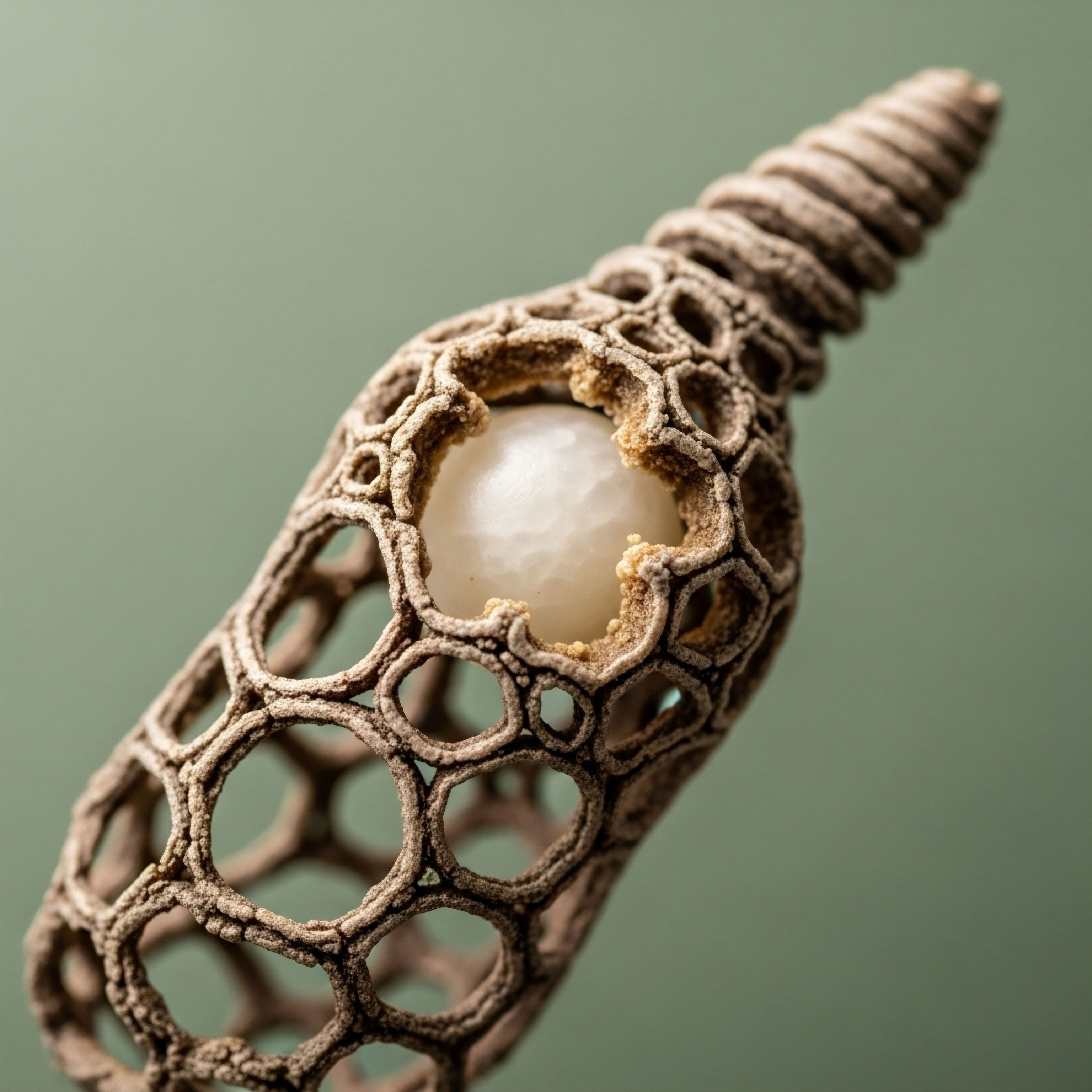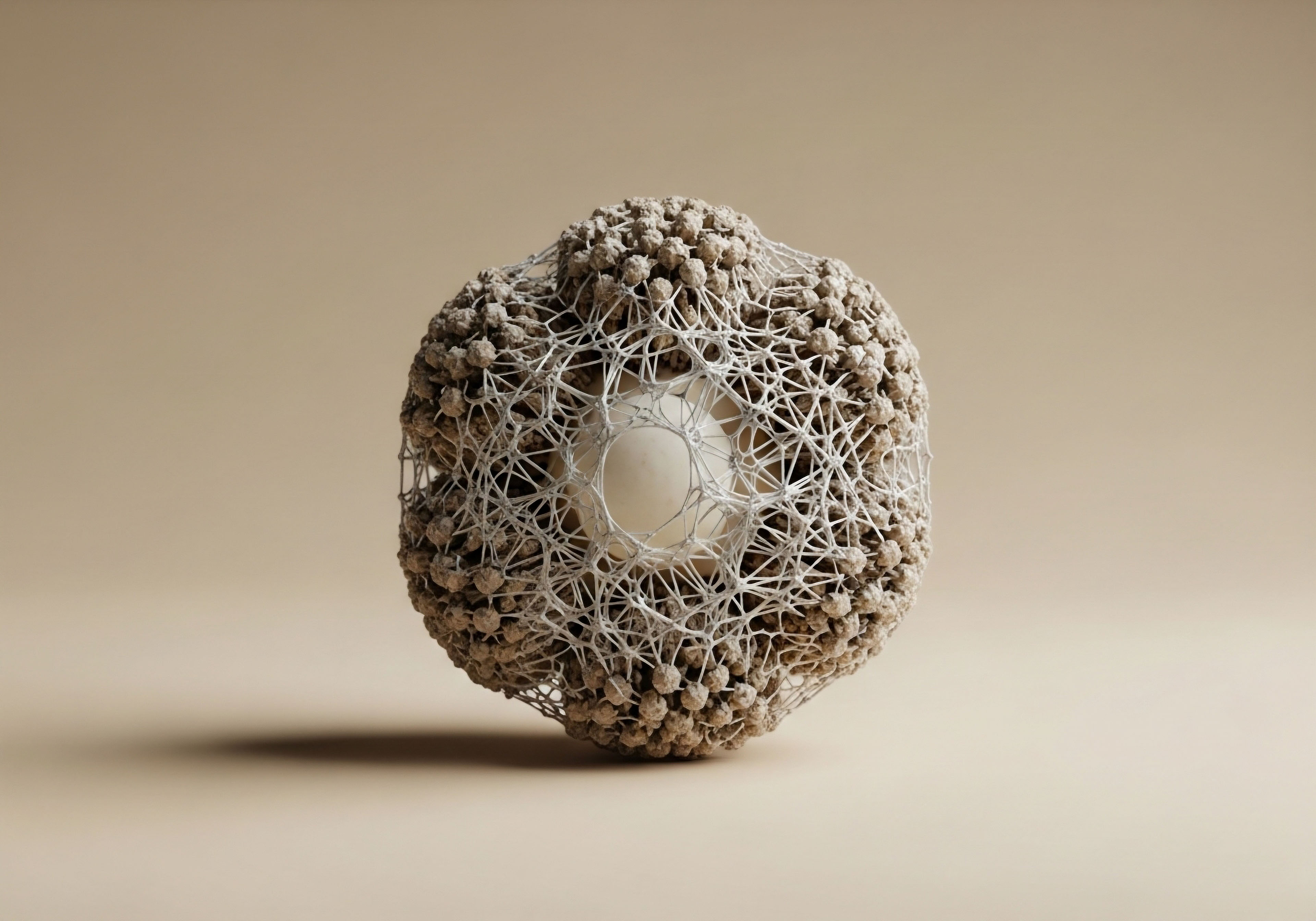

Fundamentals
You may be reading this because the straightforward solutions you have been offered for enhancing sexual function have proven insufficient. The experience of a decline in sexual vitality is deeply personal, a quiet disruption that can affect confidence and connection.
It is a journey many adults travel, often feeling that their own body is no longer responding as it once did. The frustration mounts when standard therapies provide partial results or fail altogether, leaving you to question what is truly happening within your own biological systems.
The path toward reclaiming this essential part of your life begins with understanding that sexual response is a complex interplay of mind and body, a coordinated event that requires more than a single biological switch to be flipped. It is a process originating in the intricate neural wiring of the brain and culminating in the precise vascular mechanics of the body.
When one system is supported while the other is ignored, the results are often incomplete. This exploration is for those who are ready to move toward a more complete understanding, one that honors the body’s integrated design.
At the heart of this integrated approach is the recognition of two distinct, yet profoundly connected, physiological domains. The first is the central nervous system, the command center where desire and arousal originate. This is the realm of neurotransmitters and specific neural circuits that create the mental and emotional state permissive for a sexual experience.
The second domain is the peripheral vascular system, the network of blood vessels responsible for the physical manifestation of arousal. A successful sexual response depends on the seamless communication between these two systems. When therapies only target the vascular component, they are essentially sending a message to a system that may not be receptive because the initial signal from the brain is weak or absent.
Conversely, enhancing brain-based arousal is ineffective if the physical machinery is unable to respond. True progress lies in addressing both aspects of this biological partnership.
Understanding sexual response requires appreciating the distinct roles of central nervous system arousal and peripheral vascular function.

What Is Bremelanotide PT-141
Bremelanotide, also known as PT-141, operates within the central nervous system. It is a synthetic peptide, a small protein-like molecule, designed to interact with a specific set of receptors in the brain known as melanocortin receptors.
These receptors are involved in a wide array of physiological processes, including metabolism, skin pigmentation, and, most importantly for this discussion, the pathways of sexual arousal. Bremelanotide’s action is focused on modulating these neural circuits. It helps to amplify the brain’s natural arousal signals, essentially turning up the volume on the excitatory messages that initiate the entire sexual response cascade.
Its approval by the FDA for treating hypoactive sexual desire disorder (HSDD) in premenopausal women was based on its demonstrated ability to influence this central mechanism, increasing desire and reducing the distress associated with its absence. This peptide represents a targeted intervention aimed squarely at the neurological origins of sexual function.

Understanding Complementary Therapies
Complementary therapies, in this context, primarily refer to treatments that target the vascular system or the foundational hormonal environment. The most well-known of these are the phosphodiesterase 5 (PDE5) inhibitors. This class of medication works by increasing blood flow to the genital area, facilitating the physical component of sexual arousal.
They do this by relaxing smooth muscle tissue in the blood vessel walls, allowing for the necessary engorgement required for a full physical response. Their mechanism is entirely peripheral; they do not create desire but rather enable the body to better respond to it.
Another foundational layer of therapy involves hormonal optimization, such as Testosterone Replacement Therapy (TRT). Testosterone is a critical hormone for both men and women, playing a significant role in libido, energy, and overall physiological readiness for sexual activity. When testosterone levels are suboptimal, the body’s baseline state may be ill-equipped to respond to either central or peripheral signals.
Therefore, ensuring a balanced endocrine system is a prerequisite for the success of more targeted interventions. A properly calibrated hormonal state ensures that the body’s tissues are healthy and responsive, creating a fertile ground upon which both brain-based and vascular-focused therapies can act effectively.


Intermediate
A deeper clinical perspective reveals that combining Bremelanotide with other treatments is a strategy of synergistic intervention. This approach is grounded in the physiological reality that sexual function is not a monolithic event but a sequence of dependent processes.
The clinical rationale for combination therapy is to create a multi-pronged attack on dysfunction, addressing both the initiation of desire in the brain and the execution of the physical response in the body. For many individuals, particularly men who have not had success with PDE5 inhibitor monotherapy, the issue is not solely vascular.
An underlying deficit in central arousal signaling can render PDE5 inhibitors ineffective. By pairing Bremelanotide with a PDE5 inhibitor, a clinician aims to restore the complete circuit. Bremelanotide works to prime the nervous system for arousal, while the PDE5 inhibitor ensures the vascular system is prepared to respond to that signal. This creates a more robust and reliable functional outcome.

The Clinical Mechanics of Synergy
The synergy between Bremelanotide and PDE5 inhibitors can be understood through an analogy of a two-part system ∞ an ignition and an engine. Bremelanotide acts as the ignition, targeting the melanocortin 4 receptor (MC4R) in the central nervous system to generate the initial spark of arousal.
This is a complex process involving the modulation of dopamine and other neurotransmitters that govern motivation and reward-seeking behavior. A successful activation of this pathway creates a state of heightened sexual interest and receptivity. The PDE5 inhibitor, on the other hand, functions as the engine’s fuel delivery system.
It does not start the engine, but it ensures that when the ignition is turned, the engine has the resources to run powerfully. It does this by inhibiting the enzyme phosphodiesterase type 5, which leads to increased levels of cyclic guanosine monophosphate (cGMP) in the smooth muscle cells of the arteries. This, in turn, causes vasodilation and increased blood flow.
Clinical studies have begun to explore this very synergy. Early phase research indicates that co-administering Bremelanotide with a PDE5 inhibitor may produce clinically meaningful effects in men with erectile dysfunction who are non-responders to PDE5 inhibitors alone. The development of a co-formulation that can be administered via a single injection underscores the medical interest in this combined approach, aiming to simplify treatment and improve patient adherence.
Combining therapies is a clinical strategy designed to address both the neurological “ignition” and the vascular “engine” of sexual response.

What Are the Protocols for Combined Use?
While a standardized, universally accepted protocol for combination therapy is still emerging with ongoing research, clinical practice provides some initial models. These are often personalized based on a patient’s specific history, symptoms, and response to previous treatments.
- Sequential Dosing ∞ A common approach involves the patient self-administering subcutaneous Bremelanotide (typically 1.75 mg) as needed, prior to anticipated sexual activity. This is followed by the oral administration of a standard dose of a PDE5 inhibitor within the appropriate time window for that specific medication. The goal is to have both agents reaching peak efficacy at roughly the same time.
- Hormonal Foundation ∞ Before initiating peptide or vascular therapies, a thorough assessment of the patient’s hormonal status is essential. For a man with low testosterone, a standard TRT protocol (e.g. weekly Testosterone Cypionate injections with ancillary medications like Gonadorelin and Anastrozole to maintain balance) would be established first. For a woman, hormonal evaluation might lead to low-dose testosterone therapy or progesterone support. This hormonal optimization is the foundational platform upon which other therapies are built.
- Investigational Protocols ∞ As research progresses, new delivery methods are being developed. Phase 2 clinical trials are currently investigating a co-formulation of Bremelanotide and a PDE5 inhibitor in a single injection. This would represent a significant evolution in treatment, offering a streamlined protocol designed to deliver both synergistic agents simultaneously.

Comparing Therapeutic Approaches
To fully appreciate the rationale for combination therapy, it is useful to compare it directly with monotherapy approaches. Each has a specific target, and understanding their individual limitations clarifies the value of an integrated strategy.
| Therapeutic Approach | Primary Mechanism of Action | Target Population | Key Limitations |
|---|---|---|---|
| Bremelanotide (PT-141) Monotherapy | Acts on melanocortin receptors in the central nervous system to increase sexual desire and arousal. | Primarily women with HSDD; off-label for men with low libido or ED with a psychological component. | May be insufficient if there is a significant underlying vascular or mechanical impairment. |
| PDE5 Inhibitor Monotherapy | Inhibits the PDE5 enzyme, leading to vasodilation and increased blood flow to the genitals. | Men with erectile dysfunction primarily caused by vascular issues. | Ineffective in 30-40% of patients, often due to a lack of initial central arousal signal. |
| Testosterone Replacement Therapy (TRT) | Restores systemic testosterone levels, supporting baseline libido, energy, and tissue health. | Men and women with clinically diagnosed low testosterone and associated symptoms. | Addresses the hormonal foundation but may not correct specific CNS or vascular deficits on its own. |
| Combination Therapy (Bremelanotide + PDE5i) | Simultaneously targets central nervous system arousal pathways and peripheral vascular mechanics. | Individuals, particularly men, who are non-responders to PDE5 inhibitor monotherapy. | Requires careful medical supervision; potential for compounded side effects from both agents. |


Academic
An academic exploration of combining Bremelanotide with other therapies requires a deep dive into the neuroendocrine pathways governing human sexual response. The efficacy of this synergistic approach is rooted in the distinct yet convergent mechanisms of melanocortin agonism and phosphodiesterase inhibition.
Bremelanotide, a synthetic analogue of alpha-melanocyte-stimulating hormone (α-MSH), exerts its primary influence through the melanocortin-4 receptor (MC4R). The MC4R is densely expressed in key regions of the brain, including the hypothalamus, which is the master regulator of the endocrine system and autonomic function.
Activation of the MC4R by Bremelanotide is understood to trigger a cascade of downstream neurotransmitter release, most notably dopamine in the medial preoptic area (mPOA) of the hypothalamus. This dopaminergic activity is fundamentally linked to appetitive behaviors, motivation, and the initiation of sexual interest. It is a pro-erectile and pro-arousal signal originating from the highest levels of neurological control.

The Neurobiology of Combined Intervention
The therapeutic hypothesis for combination therapy rests on a systems-biology perspective. While Bremelanotide is initiating a top-down, centrally mediated pro-sexual signal, PDE5 inhibitors are working via a bottom-up, peripherally focused mechanism. They potentiate the downstream effects of the nitric oxide (NO) pathway in the corpus cavernosum and other genital tissues.
The release of NO from nerve endings and endothelial cells is the final common pathway for achieving the vasodilation necessary for physical arousal. NO activates guanylate cyclase, which in turn produces cyclic guanosine monophosphate (cGMP), the second messenger that orchestrates smooth muscle relaxation and tumescence. PDE5 inhibitors prevent the degradation of cGMP, thereby amplifying and prolonging its effect.
The critical point of intersection is that the initial release of NO is itself dependent on nerve signals that originate from the central nervous system, the very system being primed by Bremelanotide. For a man with ED who is a PDE5 inhibitor non-responder, the problem is often an insufficient central signal to trigger the initial NO release.
The vascular machinery may be perfectly capable, and the PDE5 inhibitor may be present and ready to act, but without the initial neural impetus, the cascade never begins. Bremelanotide provides that missing impetus.
Clinical trials are actively testing this hypothesis, with Phase 2 studies underway to gather data on the efficacy of co-administered Bremelanotide and a PDE5i in this specific patient population. The expectation is that Bremelanotide will restore the central signal, allowing the PDE5 inhibitor to perform its function effectively.
The academic rationale for combination therapy lies in using a melanocortin agonist to restore the central dopaminergic signal required to initiate the peripheral nitric oxide cascade that PDE5 inhibitors amplify.

How Does This Apply to Different Patient Populations?
The application of this synergistic model varies based on the patient’s sex and underlying diagnosis. In men, the focus is clearly on overcoming PDE5 inhibitor failure in erectile dysfunction. For this group, the combination addresses a clear deficit in the response loop. The potential for a single co-formulated injection represents a significant step toward simplifying treatment for this population.
In women, the picture is slightly different. Bremelanotide is already approved for premenopausal women with HSDD, a condition characterized by a lack of sexual desire that causes personal distress. The dysfunction here is primarily central. While there is less formal research on combining Bremelanotide with other agents in women, a similar systems-based logic can be applied.
For a post-menopausal woman, for instance, atrophic changes in the genital tissues due to low estrogen can create physical discomfort that inhibits arousal. In such a case, localized estrogen therapy could be seen as a complementary treatment that addresses the peripheral tissue health, while Bremelanotide addresses the central desire deficit. Similarly, foundational hormonal support with low-dose testosterone could enhance overall sensitivity and responsiveness, allowing Bremelanotide’s central effects to be more fully expressed.

Pharmacokinetics and Trial Design Insights
The design of clinical trials for these combination therapies provides insight into their practical application. The move toward a co-formulation is particularly instructive. It suggests that the pharmacokinetic profiles of Bremelanotide and the chosen PDE5 inhibitor must be carefully matched to ensure a synchronized onset and duration of action.
| Parameter | Clinical Consideration | Rationale |
|---|---|---|
| Time to Peak Concentration (Tmax) | The Tmax of both Bremelanotide and the co-administered PDE5 inhibitor should be closely aligned. | Ensures that the central arousal signal and the peripheral vascular potentiation occur concurrently for maximum synergistic effect. |
| Half-Life (t1/2) | The duration of action for both agents should be sufficient for a typical window of sexual activity. | Provides a practical and user-friendly therapeutic window, allowing for spontaneity. Bremelanotide’s effects can last for 24 hours. |
| Route of Administration | Subcutaneous injection is the current route for Bremelanotide and the proposed route for the co-formulation. | This route offers rapid absorption and circumvents first-pass metabolism, providing predictable bioavailability. |
| Primary Endpoints in Trials | Trials typically use validated questionnaires to measure changes in erectile function, sexual desire, and distress levels. | Provides quantifiable, patient-reported outcomes to establish clinical efficacy and meet regulatory requirements for approval. |
| Safety and Tolerability | Trials must rigorously monitor for adverse events, particularly nausea, flushing, and headache, which are known side effects of Bremelanotide. | Establishes the safety profile of the combination therapy and identifies any potential for additive or unique side effects. |

References
- Palatin Technologies, Inc. “Palatin Announces the Initiation of a Phase 2 Clinical Study of Bremelanotide Co-Administered with a PDE5i for the Treatment of Erectile Dysfunction (ED).” PR Newswire, 20 June 2024.
- “Phase 2 study launches of bremelanotide plus a PDE5 inhibitor for erectile dysfunction.” Urology Times, 20 June 2024.
- “Bremelanotide Treatment Improves Sexual Function and Reduces Associated Distress Levels in Women.” HCPLive, 7 May 2014.
- Kingsberg, Sheryl A. et al. “Bremelanotide for the Treatment of Hypoactive Sexual Desire Disorder ∞ Two Randomized Phase 3 Trials.” Obstetrics & Gynecology, vol. 134, no. 5, 2019, pp. 899-908.
- “Bremelanotide (PT-141) ∞ Uses, Benefits, and Side Effects.” 1st Optimal, 22 Dec. 2024.

Reflection
The information presented here represents a shift in how we can approach personal wellness, moving from isolated fixes to integrated solutions. The science of sexual function shows us a system of profound connection, a dialogue between our brain’s intricate wiring and our body’s physiological response. Understanding this dialogue is the first step.
The journey from knowledge to personal reclamation, however, is unique to each individual. Your own biology, history, and goals define the path forward. Consider the information here not as a final answer, but as a more sophisticated set of questions to bring to a conversation about your health.
What does a truly comprehensive approach look like for you? How can understanding these complex systems empower you to seek a protocol that honors your body’s complete design? The potential for renewed vitality exists at the intersection of deep knowledge and personalized care.

Glossary

sexual function

central nervous system

nervous system

bremelanotide

hypoactive sexual desire disorder

hsdd

testosterone replacement therapy

trt

combining bremelanotide with other

pde5 inhibitor monotherapy

combination therapy

pde5 inhibitors

pde5 inhibitor

erectile dysfunction

clinical trials

combining bremelanotide with

bremelanotide with other




